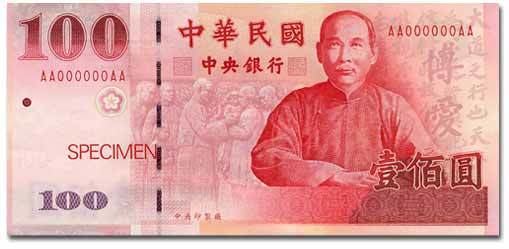NT$100 banknote obverse (1999 series) NT$1 coin Number 901 ⁄10 角jiǎo | Code TWD Exponent 2 | |
 | ||
⁄100 cent (分, fēn)Subunits used only in stocks and currencies, and rarely referred to in such cases. | ||
The New Taiwan dollar has been the currency of Taiwan since 1949, when it replaced the Old Taiwan dollar. Originally issued by the Bank of Taiwan, it has been issued by the Central Bank of the Republic of China since 2000. The currency code is TWD, and its common abbreviation is NT$.
Contents
Terminology
The Chinese term equivalent to "New Taiwan dollar", 新臺幣 or 新台幣, is used only in contexts where it is necessary to avoid any ambiguity, such as banking, contracts, or foreign exchange. In common usage, the unit is typically referred to as yuán. In Taiwan, the character for yuan can be written in either of two forms, an informal 元 or a formal 圓, which are interchangeable. Colloquial alternatives for the currency unit include the Mandarin kuài (塊), meaning "piece", and the Taiwanese Hokkien kho͘ (箍; literally "circle"). In English usage the new Taiwan dollar is often abbreviated as NT, NT$, NT Dollar or NTD, while the abbreviation TWD is typically used in the context of foreign exchange rates. Subdivisions of a new Taiwan dollar are rarely used, since practically all products on the consumer market are sold in whole dollars.
History
The New Taiwan dollar was first issued by the Bank of Taiwan on June 15, 1949, to replace the Old Taiwan dollar at a ratio of 40,000 to one. The first goal of the New Taiwan dollar was to end the hyperinflation that had plagued Nationalist China due to the Chinese Civil War.
After the communists captured Beijing in January 1949, the Nationalists began to retreat to Taiwan. China's gold reserve was moved to Taiwan in February. The government then declared in the Temporary Provisions Effective During the Period of Communist Rebellion that dollars issued by the Bank of Taiwan would become the new currency in circulation.
Even though the New Taiwan dollar was the de facto currency of Taiwan, for years the silver yuan remained the legal currency. The value of the silver yuan was decoupled from the value of silver during World War II. Many older statutes have fines and fees given in this currency.
According to statute, one silver yuan is worth three New Taiwan dollars. Despite decades of inflation, this ratio has not been adjusted. This made the silver yuan a purely notational currency long ago, nearly impossible to buy, sell, or use.
When the Temporary Provisions were made ineffective in 1991, the ROC lacked a legal national currency until the year 2000, when the Central Bank of China (CBC) replaced the Bank of Taiwan in issuing NT bills. In July 2000, the New Taiwan dollar became Taiwan's legal currency. It is no longer secondary to the silver yuan. At this time, the central bank began issuing New Taiwan dollar banknotes, and the notes issued earlier by the Bank of Taiwan were taken out of circulation.
The exchange rate compared to the United States dollar has varied from less than ten to one in the mid-1950s, more than forty to one in the 1960s, and about twenty-five to one in 1992. The exchange rate as of November 2015 is 32.7 to one.
Coins
The denominations of the Taiwan dollar in circulation are:
Coins are minted by the Central Mint of China, while notes are printed by the China Engraving and Printing Works. Both are run by the Central Bank. The NT$ 1⁄2 coin is rare because of its low value, while the NT$20 coin is rare because of the government's lack of willingness to promote it. As of 2010, the cost of the raw materials in a NT$ 1⁄2 coin was more than the face value of the coin.
Remarks
- "中華民國XX年" = "Minguo XX". "中華民國" is also the state title "Republic of China".
- "莫那魯道" = "Mona Rudao", anti-Japanese leader at the Wushe Incident.
Taiwan 100-dollar commemorative note
On 6 January 2011, the Central Bank issued a new 100-dollar legal tender circulating commemorative in celebration of the 100th anniversary of the founding of the Republic of China. The red paper note measures 145 × 70 mm and features a portrait of Dr. Sun Yat-Sen on the front, and the Chung-Shan Building on the back. The design is no different from the ordinary NT$100 note, except for the wording in Chinese language in the reverse of the note, which reads: “Celebrating the 100 years of founding of the Republic of China.”
